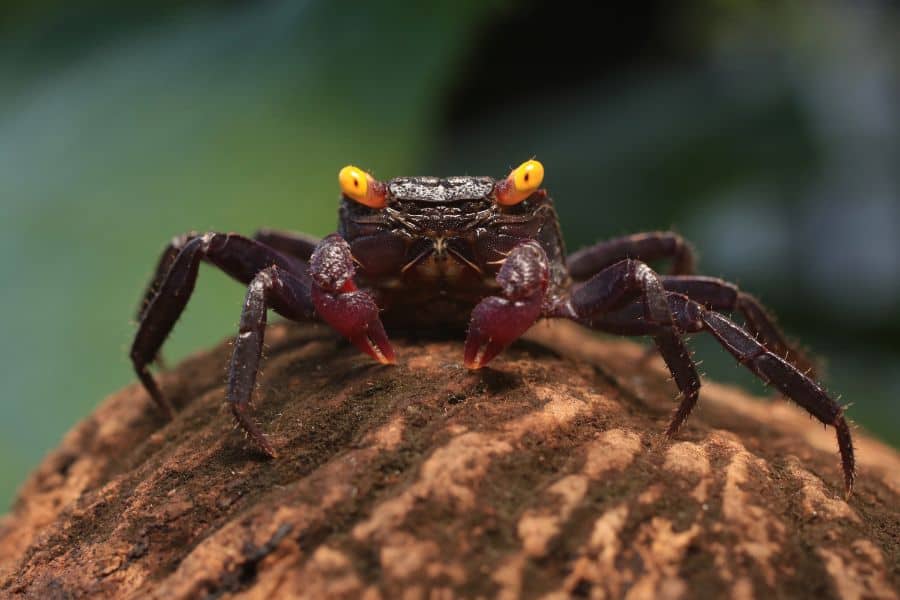The vampire crab is one of the most beautiful and unique species of crab you can own. While their care is a little different than other popular crabs in the aquarium trade (they’re semi-terrestrial), they are fairly undemanding and easy to keep.
If you’re thinking of owning a vampire crab or want to know a little more about them, our guide will cover everything you need to know about these fascinating creatures, from diet to tank setup.
Vampire Crab Overview
| Scientific Name | Geosesarma dennerle |
| Origin | Island of Java, Indonesia |
| Habitat | Near freshwater rivers and lakes in dense forests |
| Size | 2 inches |
| Temperament | Semi-aggressive |
| Diet | Omnivore |
| Lifespan | 2-3 years |
| Tank size | 10 gallons |
| Tank mates | Large shrimp and aquatic snails |
| Water parameters | 7.5-8.0 pH, 0-10 dKH, 70-82°F |
| Care level | Easy |
Vampire Crab Origins & Habitat
The vampire crab is a semi-terrestrial species that originates from the island of Java in Indonesia, but they can also be found in Sulawesi, Riau, and Krakatau. They inhabit tropical forests near freshwater rivers and streams, normally in between rocks and thick vegetation.
Interestingly, despite being a popular pet for several decades, the vampire crab wasn’t officially discovered until 2006. Unfortunately, that means there isn’t a lot of information on their care, but, hopefully, this guide will change that!
Why Are Vampire Crabs Called Vampire?
Vampire crabs get their name from their creepy appearance – they have yellow glowing eyes and off-white spots on the back of the shells. They are also a deep purple color, a shade commonly associated with vampires.
Vampire Crab Appearance
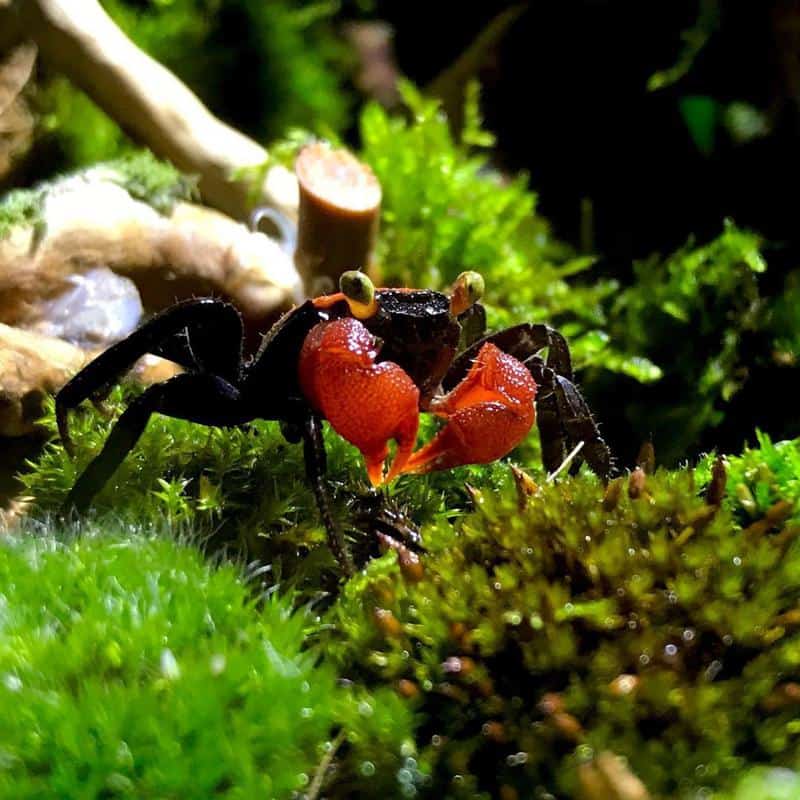
The vampire crab is one of the most striking species of semi-terrestrial crabs, which is one of the reasons why they are so popular as pets. While their profile is similar to other species of crabs (they have 10 legs and two claws), their color is completely unique.
The body (carapace) of a vampire crab is a deep purple color, though some specimens can be a more black or brownish shade.
The gorgeous purple hue that the species is recognized for is most prominent on the legs and claws. They also have yellowish-white spots on the back of their carapace that resemble a starry night, further enhancing their beauty.
Perhaps the vampire crab’s most impressive feature is its bright yellow eyes. They sit on top of stalks and make for a stunning contrast against the violet hue of the vampire crab’s carapace.
How to Sex Vampire Crabs
It can be quite difficult to tell male and female vampire crabs apart as both sexes look almost identical at first glance. That said, males are normally larger and have lighter-colored claws, though this may be hard to identify unless you have multiple vampire crabs.
Another way you can sex purple vampire crabs is by looking at their abdominal flaps (you’ll probably need to hold the crab and flip it over to do this!). Females have wide oval flaps, whereas males have thin and pointed abdominal flaps.
Vampire Crab Size
Vampire crabs are fairly small as they only reach around 2 inches in size, including their legs and claws. Males tend to be a little bigger than females, but they will rarely exceed 2 inches.
Are Vampire Crabs Expensive?
Yes, vampire crabs can be rather expensive! Despite being fairly easy to hunt down at fish stores, most places price them between $10 to $20.
This can quickly add up if you want to add multiple vampire crabs to your tank, which is preferable as they enjoy the company of their own kind.
Vampire Crab Lifespan
Unfortunately, vampire crabs don’t have a very long life expectancy as most specimens only reach around 2 to 3 years of age.
That said, good water quality, the right tank setup, and a varied diet can help you get the most out of your vampire crab and ensure they live as long as possible.
Vampire Crab Behavior
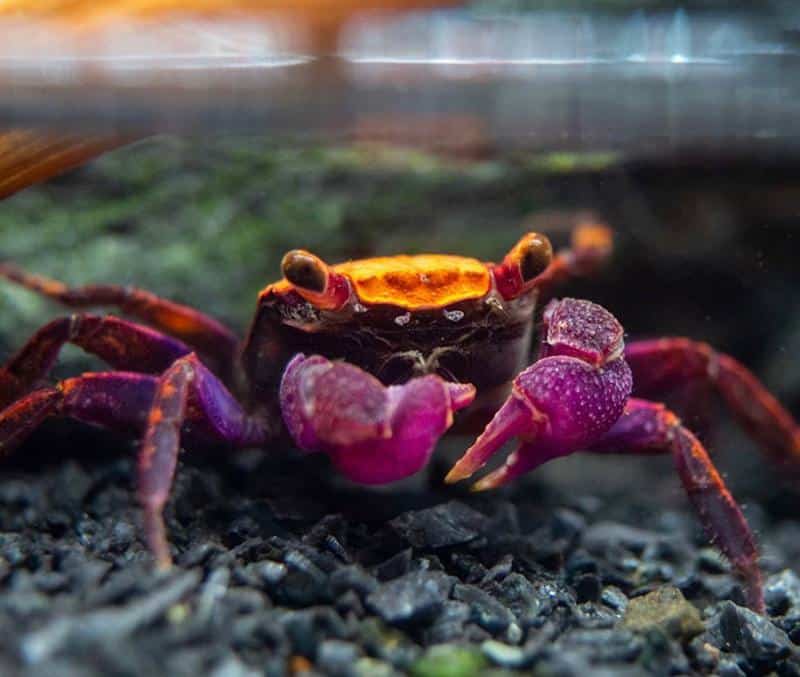
Just like their name suggests, vampire crabs are nocturnal, which means they are most active at night. They spend most of their time on land, but they also enjoy being underwater.
They like climbing and exploring, but it’s not uncommon for them to rest for long periods on a perch or a flat surface, often completely still.
Vampire crabs are very social with their own kind, but they can be aggressive towards other crabs and small fish. Males can also be territorial during the mating season.
Vampire crabs have a tough exoskeleton to help protect them from predators, but they need to shed it every so often so they can make room for a larger one as they develop. Young crabs molt very frequently until they are around 6 months of age.
After this age, vampire crabs normally molt monthly. Freshly molted crabs are very vulnerable, so they will usually hide for a few days until their new shell has had time to harden.
Try not to disturb your vampire crab after they have just molted. You should also make sure your enclosure has plenty of hiding spots that they can retreat to.
Are Vampire Crabs Aggressive to Humans?
Vampire crabs aren’t usually aggressive to humans, though they can be quite territorial towards other species of crabs and bottom-dwellers.
Due to their tiny size and small claws, vampire crabs are harmless to humans even if they were to act aggressively.
How to Care for Vampire Crabs
Although vampire crab care is quite straightforward, this species is a little different from most other types of crabs available in the fishkeeping hobby as they are semi-terrestrial.
An entirely underwater environment won’t suffice for a vampire crab as they need both dry and wet areas to survive. Instead, you’ll need to set up a vampire crab paludarium.
If you’re unfamiliar with this type of enclosure, it’s a terrarium that features both terrestrial (land) and aquatic sections.
This is probably the most challenging component of vampire crab care, but once you have your paludarium up and running, it should be smooth sailing from there!
Vampire crabs are fairly low-maintenance as long as their environment meets their needs.
Are Vampire Crabs Freshwater?
Vampire crabs aren’t exactly freshwater as they are semi-terrestrial, which means they live partly on land and partly in water.
However, the water in their tank should be freshwater and warm as they originate from tropical climates.
Vampire Crab Tank Size
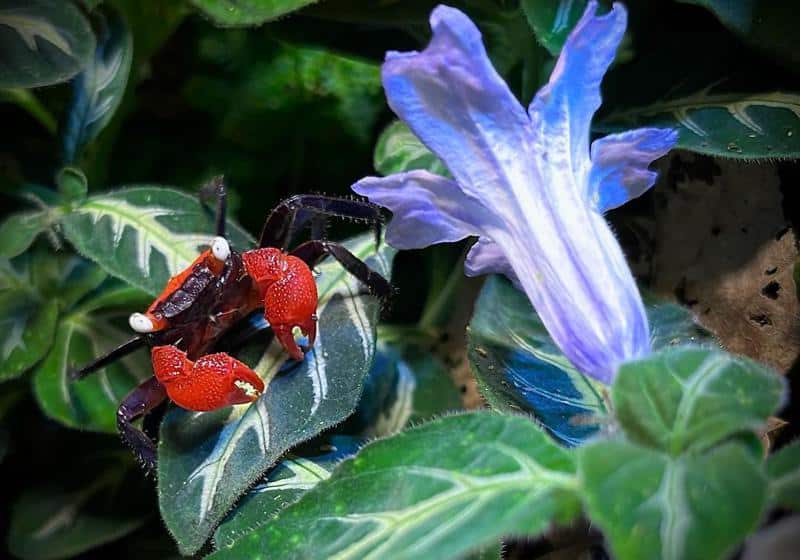
The minimum tank size for a vampire crab is 10 gallons, though bigger is always better, especially if you plan on keeping more than one crab.
Although some aquarists recommend 5 gallons for this species, this seems a little small, especially as vampire crabs need both dry and wet areas in their tank.
Vampire Crab Tank Setup
As mentioned earlier, purple vampire crabs need to be housed in a paludarium as they are semi-terrestrial. The species spends most of their time on land, but they still need a bit of water, so you’ll need to make sure their habitat incorporates both dry and aquatic areas.
It’s generally recommended to have a land-to-water ratio of 80:20, so you only need a small water pool for your crab. Make sure the pool can cover the entirety of your vampire’s crab body and has surfaces (rocks or driftwood) that can allow them to easily enter and exit the water.
Vampire crabs can drown if they are unable to get to dry land, so it’s really important that the pool isn’t overly deep (around 4 to 6 inches deep is ideal)!
Plants & Decorations
Adding plants, rocks, wood, perches/ledges, and other decorations to your vampire crab paludarium is a great way to provide enrichment and hiding spaces for your pet.
Feel free to use natural or artificial decorations, though the former will create a more organic environment. Vampire crabs don’t eat live plants (they will eat dead ones, though!), so you can add as much vegetation as you like.
You can use a combination of aquatic and houseplants – some great options include java moss, anubias, water lettuce, pothos, creeping fig, and philodendron.
Driftwood, rocks/stones, and even some leaf litter can also be introduced to land and aquatic sections to make your vampire crab feel more at home.
Substrate
Vampire crabs aren’t picky when it comes to substrate, so you can use sand, gravel, soil, coconut fiber, or sphagnum moss (or a mixture of any of these!).
However, this species likes to dig and burrow, so a more malleable substrate like soil or sand may be preferable.
Filtration
As vampire crabs don’t need a lot of water in their paludarium, you can get by with a simple filtration system like an underwater gravel filter or hang-on-back filter in a small vampire crab habitat.
Larger paludariums, however, will need more filtration to keep the water clean, so a canister filter might be a better option.
Heater & Humidifier
Two components that are often missed in a vampire crab tank are a heater and a humidifier. Both of these are crucial as the species originates from a tropical and humid climate.
An aquarium heater will help keep the aquatic area of your setup warm, while a humidifier will increase the temperature and humidity of the dry sections.
Vampire Crab Tank Mates
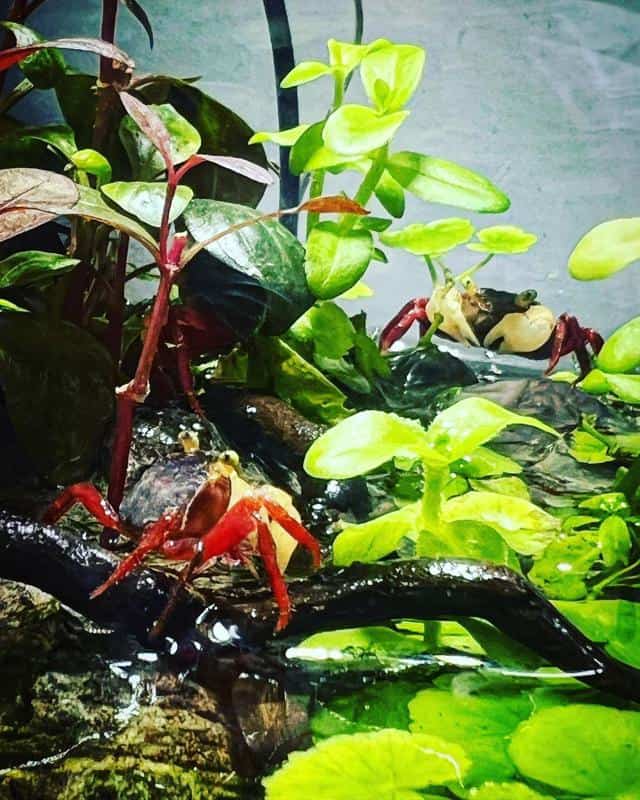
The best tank mates for a vampire crab are other vampire crabs as they like to be kept in groups. A 10-gallon tank is plenty for around 6 crabs due to their tiny size.
Although peaceful with their own kind, purple vampire crabs can be aggressive towards other creatures, especially other species of crabs. In addition, large fish will view them as prey.
You’ll need to choose your vampire crab tank mates carefully to ensure the safety of all parties.
Large shrimp and aquatic snails make decent roommates for vampire crabs, but very small fish will likely be eaten by your crabs.
It’s best to select fast-moving fish with short fins that won’t be an easy target for your vampire crab (and vice versa). Some good options include cherry barbs, short-finned betta, danios, and female guppies.
Bear in mind that there is no guarantee that your vampire crab won’t try to prey on their tank mates, so you may lose the odd one. You’ll also need to make sure the aquatic area in your paludarium is large enough to accommodate other residents.
How Many Vampire Crabs Should I Keep?
Vampire crabs are social, so you should aim to house at least 6 in a 10-gallon tank. Ideally, you should keep a single male with several females unless you have a spacious paludarium as males can be quite territorial, even more so during mating season.
Ideal Vampire Crab Water Parameters
Vampire crabs can be fairly sensitive to water quality and parameters, so you need to monitor the water chemistry and cleanliness of the underwater section in your paludarium closely. This can be done using aquarium testing strips or kits and by performing regular water changes.
pH
Although vampire crabs don’t need a lot of water in their setup, you still need to make sure the pH is to their liking. They prefer slightly alkaline water at a pH of around 7.5 to 8.0 – if the pH is too low, your crab will become less active.
Water Hardness
The recommended water hardness range for vampire crabs is 0 to 10 dKH. The key to keeping your vampire crab happy is by making sure your water parameters are stable and don’t fluctuate constantly.
Water Temperature
As vampire crabs are a tropical species of crab, they need warm water in their paludarium, ideally at a temperature between 70°F to 82°F (somewhere in the center of this range is preferable).
What Do Vampire Crabs Eat?
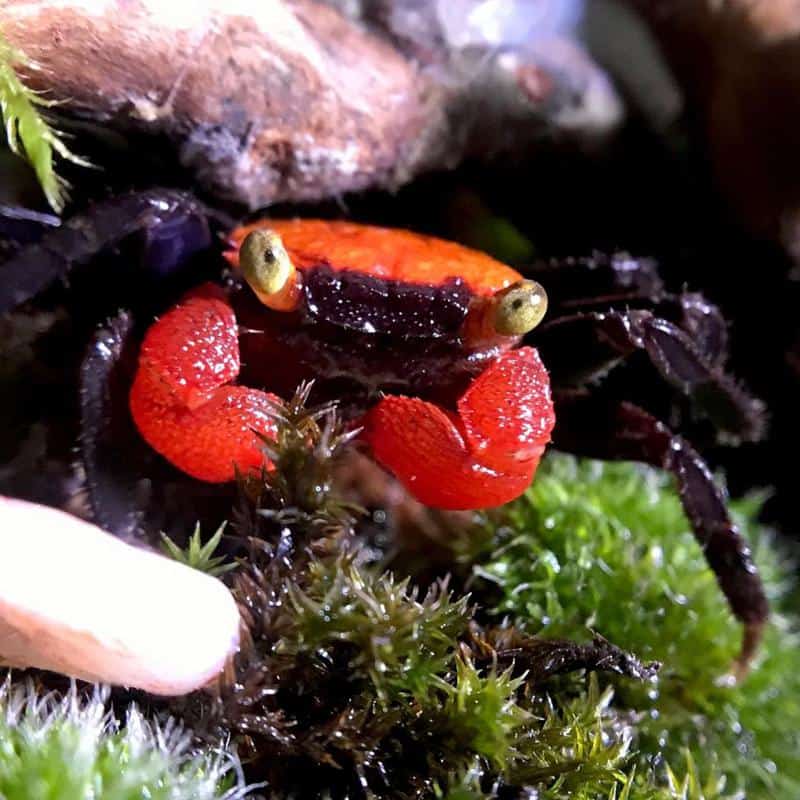
The vampire crab is an omnivore, which means they feed on both plant matter and meaty foods. In the wild, they consume decaying plants, small crustaceans, small fish, and insects – they’re true scavengers!
Vampire crabs are easy to feed in captivity as they’ll eat just about anything. You can offer them live and frozen foods like bloodworms, grasshoppers, crickets, earthworms, chopped shrimp/krill, high-quality fish flakes/pellets, algae wafers, and fruits or vegetables.
Be sure to mix up your vampire crab’s diet regularly and feed them a variety of foods to keep them healthy.
Vampire Crab Breeding
Vampire crabs are easy to breed and will likely mate without intervention provided they are kept in groups with males and females (remember, one male to several females as males are territorial).
However, feeding your crabs well and keeping their habitat clean will encourage them to breed sooner. Most vampire crabs become sexually mature at around 6 months of age, so if your crabs are younger than this, they may not be ready to breed just yet.
During mating, the male vampire crab will mount the female to fertilize her eggs. Females carry roughly 20 to 80 eggs for approximately a month. Once the eggs hatch, the babies will look exactly like their adult counterparts, just a lot smaller!
Baby vampire crabs are independent from the get-go, so they do not require the care of their parents or special attention from you – simply feed and care for them the same as you would for the adults.
Vampire crabs can consume their own young, so you may want to move the babies to a separate enclosure until they are bigger enough to return to your main vampire crab habitat.
Read More:
Final Thoughts
Vampire crabs are one of the most interesting pets you can own, from their spooky appearance to their unique tank setup. Thankfully, these creatures have straightforward care – the only real challenge is their enclosure.
However, once their habitat is sorted, vampire crabs are pretty undemanding. All you need to do is keep their enclosure clean, monitor their water parameters, and feed them a varied diet. That’s all there is to it to keep your new pet happy and healthy!
